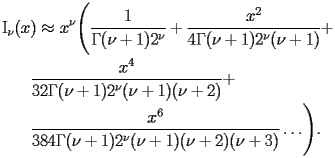BSI Bessel I
BSI.1 Introduction |
top up back next into bottom |
Let
 be a complex variable of
be a complex variable of
 and let
and let
 denote a parameter (independent of
denote a parameter (independent of
 ).The function Bessel I (noted
).The function Bessel I (noted
 ) is defined by the following second order differential equation
) is defined by the following second order differential equation
| BSI.1.1 |
Although
 is a singularity of BSI.1.1, the initial conditions can be given by
is a singularity of BSI.1.1, the initial conditions can be given by

|
BSI.1.2 |
The formulae of this document are valid for

Related function: Bessel K
BSI.2 Series and asymptotic expansions |
top up back next into bottom |
BSI.2.1 Asymptotic expansion at
|
top up back next into bottom |
BSI.2.1.2 General form |
top up back next into bottom |
BSI.2.1.2.1 Auxiliary function

The coefficients
 of
of
 satisfy the following recurrence
satisfy the following recurrence

|

|

|
BSI.2.2 Asymptotic expansion at
|
top up back next into bottom |
BSI.2.2.2 General form |
top up back next into bottom |
| BSI.2.2.2.1 |
 satisfy the recurrence
satisfy the recurrence
| BSI.2.2.2.2 |
| BSI.2.2.2.3 |
| BSI.2.2.2.4 |











